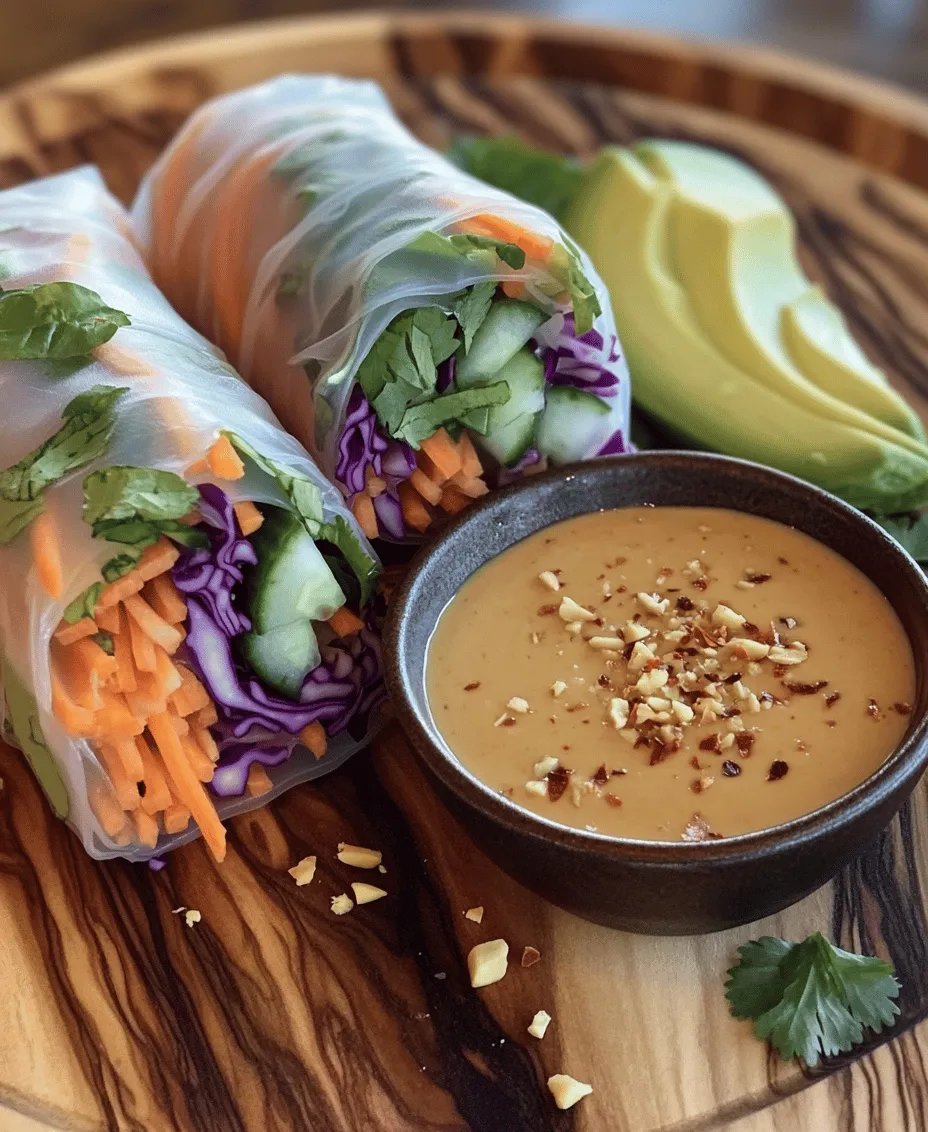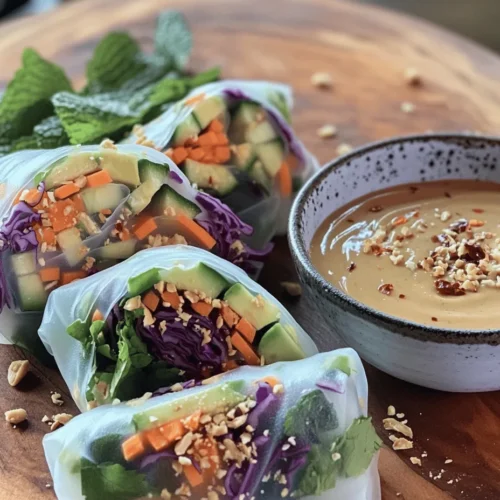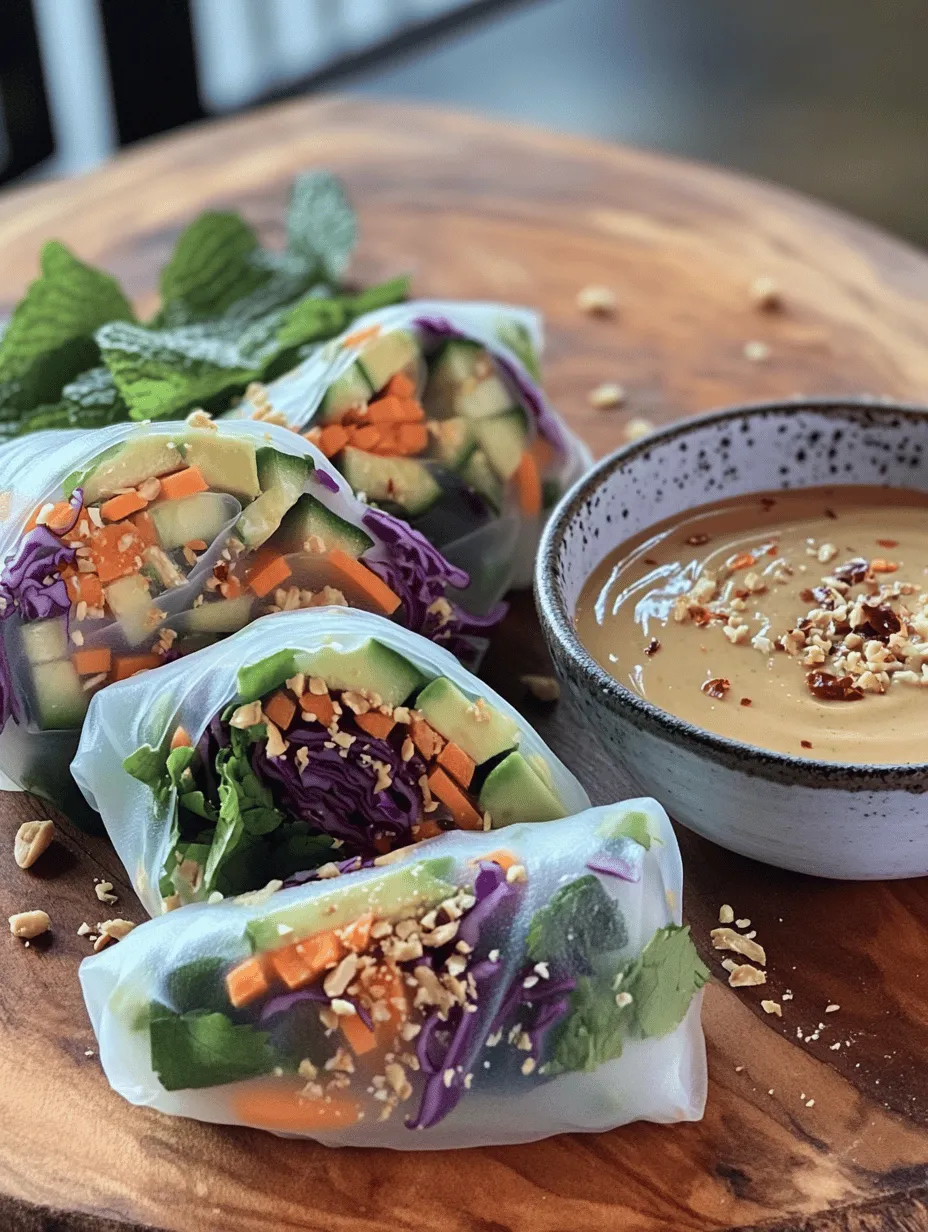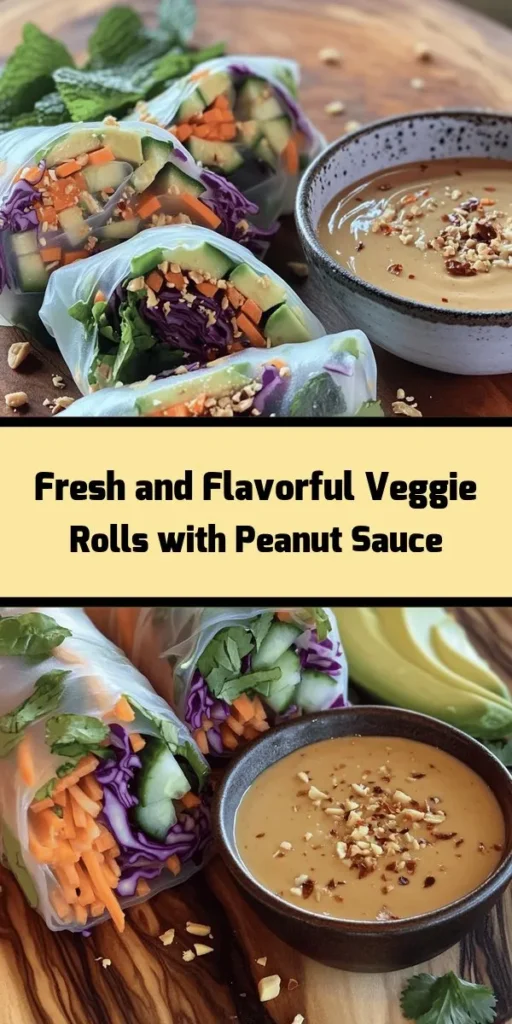Introduction
Veggie rolls have surged in popularity as a go-to dish for health-conscious eaters and culinary enthusiasts alike. These delightful wraps are not only visually appealing but also bursting with fresh flavors and nutrients. Made primarily with an array of colorful vegetables, fresh herbs, and often accompanied by a rich and creamy sauce, veggie rolls offer a satisfying and wholesome option for lunch, dinner, or even as an appetizer.
What makes veggie rolls particularly appealing is their versatility; they can be customized to suit various dietary preferences, whether you are vegan, vegetarian, gluten-free, or simply looking for a lighter meal. The combination of fresh ingredients creates a delightful crunch, while the dipping sauce adds a burst of flavor that elevates the dish to new heights. Whether you enjoy them as a light snack or a full meal, these hearty veggie rolls with peanut sauce are sure to become a favorite in your recipe repertoire.
Understanding the Ingredients
Creating the perfect veggie roll starts with selecting high-quality ingredients. The primary components of these rolls include fresh vegetables, herbs, rice paper wrappers, and a savory peanut sauce. Let’s take a closer look at each element.
The Primary Components of the Veggie Rolls
The foundation of any great veggie roll is the vegetables. Common choices include:
– Carrots: Crisp and slightly sweet, carrots add a delightful crunch and are packed with beta-carotene, which contributes to eye health.
– Cucumbers: Refreshing and hydrating, cucumbers provide a cool contrast to the heartier flavors of the other ingredients.
– Bell Peppers: Available in a rainbow of colors, bell peppers are rich in antioxidants and vitamin C, enhancing both flavor and nutrition.
– Avocado: Creamy and rich, avocado not only adds a luscious texture but also provides healthy fats that keep you feeling satisfied.
Benefits of Using Rice Paper Wrappers
Rice paper wrappers are a staple in many Asian cuisines and are the perfect vessel for holding all the delicious fillings. Made from rice flour and water, these wrappers are gluten-free and incredibly versatile. They become soft and pliable when soaked in warm water, allowing you to wrap your ingredients without worrying about breakage.
Rice paper wrappers are low in calories and carbohydrates, making them an ideal choice for those looking to enjoy a lighter meal. They also add a unique texture that complements the crunchy vegetables inside, making each bite a delightful experience.
Nutritional Advantages of the Selected Vegetables
Incorporating a variety of vegetables into your rolls not only enhances the flavor but also contributes to a well-rounded nutritional profile. Each vegetable offers unique health benefits:
– Carrots: High in fiber and antioxidants, carrots are great for digestion and improve skin health.
– Cucumbers: Low in calories but high in water content, cucumbers are excellent for hydration and weight management.
– Bell Peppers: Their vibrant colors indicate a wealth of vitamins and minerals, particularly vitamin C, which supports the immune system.
– Avocado: Rich in monounsaturated fats, avocados help promote heart health and keep you feeling full longer.
The Role of Fresh Herbs in Enhancing Flavor
Fresh herbs play a crucial role in achieving a vibrant flavor profile in your veggie rolls. Herbs such as cilantro, mint, and basil not only add freshness but also bring their unique aroma and taste to the dish. Cilantro adds a bright, citrusy flavor, while mint provides a refreshing bite. Basil, with its slightly sweet and peppery notes, complements the other ingredients beautifully.
Optional Addition of Rice Noodles for Heartiness
For those looking to make their veggie rolls even more filling, consider adding rice noodles. These thin, delicate noodles are made from rice flour and provide an additional layer of texture. They are quick to prepare and can help create a more substantial meal, perfect for those with larger appetites or active lifestyles.
Detailed Description of the Peanut Sauce Ingredients
A standout feature of veggie rolls is the accompanying peanut sauce, which brings everything together with its creamy, nutty goodness. The key ingredients for a classic peanut sauce typically include:
– Peanut Butter: The star of the sauce, peanut butter is rich in protein and healthy fats. It adds a rich creaminess and nutty flavor that pairs perfectly with the freshness of the veggie rolls.
– Soy Sauce: This adds umami depth and saltiness, enhancing the overall flavor of the sauce.
– Lime Juice: A splash of lime juice brightens the sauce, providing a tangy contrast to the richness of the peanut butter.
– Honey or Maple Syrup: A touch of sweetness balances the savory elements and adds complexity to the sauce.
– Garlic and Ginger: Freshly minced garlic and ginger lend a warm, aromatic flavor that elevates the sauce.
– Water: Used to achieve the desired consistency, water helps thin the sauce without compromising its flavor.
Nutritional Benefits of Peanut Butter
Peanut butter is more than just a delicious addition; it offers a myriad of health benefits. Rich in protein, fiber, and essential fatty acids, peanut butter promotes satiety and can help maintain energy levels throughout the day. It also contains antioxidants and vitamins, such as vitamin E and magnesium, which support overall health.
Role of Each Ingredient in Achieving a Balanced Flavor Profile
The combination of these ingredients creates a harmonious balance of flavors in the peanut sauce. The nuttiness of the peanut butter, the saltiness from the soy sauce, the acidity of the lime juice, and the sweetness from honey come together to create a sauce that perfectly complements the fresh vegetables in your rolls. This balance is essential for creating a dish that is not only delicious but also satisfying and nutritious.
Preparation Steps for Hearty Veggie Rolls
Preparation is key when assembling your hearty veggie rolls. Taking the time to properly prep your ingredients will ensure that your rolls are easy to assemble and visually appealing.
Importance of Prepping Ingredients for Optimal Assembly
Before diving into the assembly process, gather all your ingredients and equipment. This includes your vegetables, herbs, rice paper wrappers, and peanut sauce ingredients. Having everything within reach will streamline the process and help you create beautiful rolls without any stress.
Detailed Instructions on Washing, Cutting, and Arranging Veggies and Herbs
1. Wash the Vegetables: Begin by thoroughly washing all your vegetables under cold running water. This step is crucial for removing any dirt or pesticide residues.
2. Cut the Vegetables:
– Peel the carrots and cut them into thin matchsticks.
– Slice the cucumbers lengthwise and then into thin strips.
– Remove the stems from the bell peppers, discard the seeds, and slice them into thin strips.
– If using avocado, cut it in half, remove the pit, and slice it into thin pieces.
3. Prepare the Fresh Herbs: Rinse the fresh herbs and gently pat them dry with a paper towel. Remove any thick stems, as they can be tough to chew.
4. Arrange the Ingredients: Lay out all the prepared vegetables and herbs on a clean cutting board or a large plate. Organizing them in a way that is easy to access during assembly will make the process smoother.
Visual Cues for Recognizing When Ingredients Are Ready
When preparing your ingredients, look for visual cues to ensure they are ready for assembly. For example, vegetables should be brightly colored and crisp, while herbs should be fresh and vibrant. Avoid using wilted or discolored ingredients, as they can detract from the overall appeal of your veggie rolls.
Step-by-Step Guide to Making the Peanut Sauce
1. Combine Ingredients: In a medium mixing bowl, combine the peanut butter, soy sauce, lime juice, honey or maple syrup, minced garlic, and ginger.
2. Whisk Together: Using a whisk or fork, blend the ingredients until smooth. If the mixture is too thick, gradually add water a tablespoon at a time until you reach your desired consistency.
3. Taste and Adjust: Taste the peanut sauce and adjust the flavors to your liking. If you prefer it sweeter, add more honey; if you like it saltier, add a touch more soy sauce.
4. Set Aside: Once the sauce is well combined and balanced, set it aside while you prepare the rice paper wrappers.
Tips for Achieving the Perfect Consistency Without Lumps
To ensure your peanut sauce is smooth and free of lumps, make sure to whisk thoroughly. If you find that lumps persist, consider using a blender or food processor to achieve a creamier texture. Additionally, adding the water gradually will help control the consistency without making the sauce too runny.
Flavor Balancing Techniques (Sweetness, Saltiness, Acidity)
Balancing the flavors of your peanut sauce is crucial for creating a dish that excites the palate. Here are some tips for achieving that perfect balance:
– Sweetness: If your sauce tastes too salty or tangy, add a little more honey or maple syrup to round out the flavors.
– Saltiness: If the sauce is too sweet, a splash more soy sauce can enhance the umami flavor while balancing the overall taste.
– Acidity: For a brighter flavor, increase the amount of lime juice. Acidity can help cut through richness and elevate the dish.
Crafting the Perfect Veggie Rolls
With all your ingredients prepped and your peanut sauce ready, it’s time to assemble your hearty veggie rolls. The following steps will guide you in creating perfectly wrapped rolls that are as beautiful as they are delicious.
Detailed Instructions for Soaking Rice Paper Wrappers
1. Prepare a Shallow Dish: Fill a large shallow dish, such as a pie plate or a wide bowl, with warm water. The water should be warm enough to soften the rice paper but not too hot to handle.
2. Soak the Wrappers: Take one rice paper wrapper and submerge it in the warm water for about 10-15 seconds. You want it to become pliable but not overly soft, as it will continue to soften once you remove it from the water.
3. Transfer to a Clean Surface: Carefully lift the softened rice paper wrapper out of the water and gently shake off any excess water. Place it flat on a clean, damp kitchen towel or a cutting board.
4. Assemble the Rolls: In the center of the wrapper, layer a small handful of each prepared vegetable and a few fresh herbs. If you are using rice noodles, add a small portion to the mix as well.
5. Wrap It Up: Fold the sides of the wrapper over the filling, then roll it tightly from the bottom up, tucking in the sides as you go to secure the filling. Be gentle but firm to avoid tearing the wrapper.
By following these steps, you will create hearty veggie rolls that are not only nutritious but also bursting with flavor. The combination of fresh vegetables, aromatic herbs, and creamy peanut sauce makes for a delightful dish that is sure to impress. Continue exploring the next steps to complete your culinary journey with these delicious veggie rolls.

Importance of Water Temperature and Soaking Time for Pliability
When preparing your Hearty Veggie Rolls, the temperature of the water used for soaking the rice paper wrappers is crucial. Ideally, you should use warm water—around 110°F (43°C)—to create a pliable texture that allows for easy handling. Cold water may not soften the wrappers sufficiently, while boiling water can make them too soft and prone to tearing.
Soaking time is equally important. Generally, a soak of 10 to 15 seconds is sufficient, but you should keep an eye on the texture. The wrappers should be soft but still slightly firm when you remove them from the water, as they will continue to soften while you assemble the rolls. This careful attention to water temperature and soaking time will ensure that your veggie rolls are perfectly pliable and ready for rolling.
Tips on Handling and Laying Out the Wrappers
Once your wrappers are soaked, it’s essential to handle them with care. Lay each wrapper flat on a clean, damp kitchen towel or a cutting board. This will prevent the wrappers from sticking and tearing. Have your ingredients prepared and ready to go before you soak the wrappers, as you want to assemble them while they are still warm and workable.
To maintain a clean workspace, consider using separate sections of the board for different ingredients. This organization will streamline your rolling process and prevent last-minute scrambling for ingredients.
Comprehensive Guide to Assembling the Rolls
Assembling your Hearty Veggie Rolls is an enjoyable and creative process. Here’s how to do it:
1. Prepare Your Ingredients: Start by gathering all your filling ingredients. Thinly slice vegetables like bell peppers, cucumbers, carrots, and avocado. You can also include fresh herbs such as cilantro and mint for added flavor.
2. Lay Out the Wrapper: Place the soaked rice paper wrapper on your damp surface. You can position it in a diamond shape with one corner facing you, which makes rolling easier.
3. Start with a Base: Begin by adding a small handful of leafy greens (like lettuce or spinach) towards the bottom third of the wrapper. This will act as a base for your fillings.
4. Layer Your Ingredients: Next, add your sliced vegetables and herbs on top of the greens. Be mindful of the placement; distribute them evenly across the width of the wrapper.
Strategic Placement of Ingredients for Even Distribution
When layering your ingredients, make sure to leave about an inch of space on the sides and the top for folding. This ensures that your fillings won’t spill out when rolling. An effective method is to arrange your ingredients in a horizontal line, creating a colorful and vibrant display. The more colorful your ingredients, the more appealing your rolls will look when served.
How to Avoid Overfilling and Tips for Efficient Rolling
One common mistake is overfilling the rolls, which can lead to tearing and difficulty in rolling. Stick to about a quarter cup of fillings per roll, adjusting based on the size of your wrappers. Once you have added your fillings, it’s crucial to roll the wrapper tightly but not excessively.
Techniques for Rolling the Veggie Rolls Without Tearing the Wrappers
To roll your veggie rolls without tearing the wrappers, follow these steps:
1. Fold the Bottom Up: Start by folding the bottom corner of the wrapper over the filling.
2. Fold the Sides In: Next, fold in the left and right corners towards the center of the roll. This will help keep the fillings secure.
3. Roll it Up: Gently but firmly roll the wrapper away from you, keeping it as tight as possible without squishing the fillings.
Visual Descriptions of the Rolling Process for Clarity
Imagine the smooth, translucent rice paper hugging the vibrant colors of your fresh vegetables, creating a beautiful, edible package. As you roll, the soft texture of the wrapper conforms to the shape of the fillings, creating a compact roll that is both visually appealing and bursting with flavor. The final product should resemble a neat cylinder, showcasing the colorful ingredients peeking through the wrapper.
Serving Suggestions and Pairing Ideas
Once your Hearty Veggie Rolls are assembled, presentation is key. Arrange them on a serving platter, preferably in a circular pattern, to create an inviting display.
Garnish the rolls with crushed peanuts and a sprinkle of chili flakes for added texture and flavor. These garnishes not only enhance the visual appeal but also add a delightful crunch and spice that will elevate your dining experience.
To complement the rolls, consider additional dipping sauces such as spicy sriracha, sweet chili, or a tangy tamari sauce. These sauces provide a variety of flavors that can cater to different palates.
Furthermore, pairing your veggie rolls with dishes like a light Asian-inspired salad or a refreshing cucumber soup can create a well-rounded meal. For beverages, iced green tea, coconut water, or a light sparkling water with a hint of lime will enhance the fresh flavors of the rolls.
If you want to incorporate seasonal variations, consider adding ingredients like roasted squash in the fall or fresh berries in the summer. These adaptations can keep the recipe exciting and allow for exploration of different flavor profiles.
Health Benefits of Hearty Veggie Rolls
The nutritional analysis of the ingredients in your Hearty Veggie Rolls showcases their health benefits. The primary ingredients, including fresh vegetables, healthy fats from peanuts, and rice paper wrappers, contribute to a well-balanced meal.
These veggie rolls are low in calories, with a typical serving containing approximately 120-150 calories, depending on the filling ingredients. They are packed with vitamins A and C from the vegetables, as well as healthy fats and protein from the peanut sauce, making them a nutrient-dense choice.
Incorporating a variety of vegetables into your diet has numerous health benefits. A diet rich in vegetables can help lower the risk of chronic diseases, improve digestion, and support overall health. The healthy fats present in peanuts are beneficial for heart health and can help improve cholesterol levels.
These Hearty Veggie Rolls fit seamlessly into various dietary lifestyles, including vegan, vegetarian, and gluten-free. The versatility of this recipe allows everyone to enjoy a nutritious meal, regardless of dietary restrictions.
Conclusion
Making and enjoying homemade Hearty Veggie Rolls is a joyful experience that combines creativity and nutrition. The rolling process is not only a fun culinary activity but also a way to explore the vibrant flavors and textures of fresh vegetables.
With their versatility and health benefits, these veggie rolls are a fantastic addition to any meal, allowing you to experiment with different ingredients and flavors. Whether you’re preparing them for a family dinner, a picnic, or a healthy snack, the Hearty Veggie Rolls are sure to impress and satisfy.
We encourage you to explore your creativity with this recipe, trying out new combinations of veggies, sauces, and seasonings. The possibilities are endless, and the joy of creating your own personalized rolls is unmatched. Enjoy your culinary adventure!



